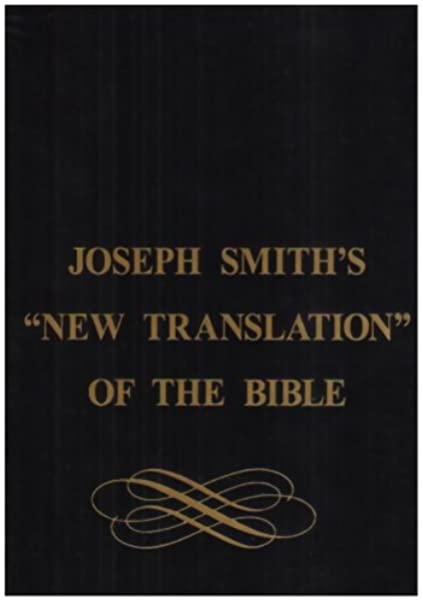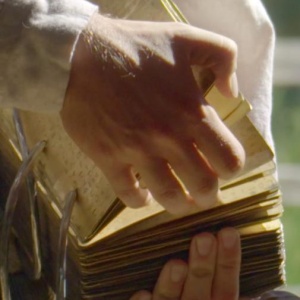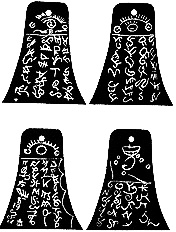Category: Latter-day Saint Thought
-
“You shall obtain a view of them”
What were the three witnesses promised and what did they claim to experience? The basics of answering this question seems obvious—they saw the gold plates and other artifacts related to them. What is less apparent is how the Three Witnesses had that experience, since there are indications that they viewed the plates in vision, rather…
-
“The keys of the ministering of angels”
One of the persistent questions from Doctrine and Covenants, Section 13 is what is meant by the statement that the Priesthood of Aaron “holds the keys of the ministering of angels.” Answers from general authorities in recent years have varied, including the idea that the Aaronic priesthood comes with a special privilege to have the…
-
“I will establish my church”
Doctrine and Covenants Section 10 is interesting in its discussion of the Lord’s church because it seems to use the term in two different ways. One definition is the institution that we’re most likely to think of when we hear the term—the one we call Church of Jesus Christ of Latter-day Saints. The second is…
-
Deny not the Spirit of Revelation-a reflection on Come Follow Me
The story of the First Vision is one of the most beloved in all the Gospel, and many of us have sat through multitudes of lessons on what truths this vision taught, one of which being that the creeds of all of the other religions are an abomination to God. Sometimes this has been interpreted…
-
At Home with Nothing to do? Try a Zion Project
I am currently serving as the RS president in our ward. Basically I have spent the last almost year pining and waiting for things to get back to normal, but lately I have been thinking that maybe that is not at all what I want. Don’t get me wrong, I can’t wait until we can…
-
“You have another gift”
In a land of myth and a time of magic, the destiny of a great kingdom[1] rests on the shoulders of a young man. His name … Joseph. If you couldn’t tell from the text above, my wife and I have been watching the TV series Merlin lately. We’ve rather enjoyed their take on the…
-
“Let God Prevail”
I share here a sacrament meeting talk I delivered recently in my St Louis congregation. I suspect there have been many other such sermons on the same topic delivered in wards around the globe over the past three months. President Nelson’s October address seems to have made a powerful impression on our people in this…
-
Louis Midgley on Hugh Nibley, the Maori, and More
In an interview ranging from discussing Hugh Nibley to missionary work in New Zealand to systematic theologies to the dedication of the Swiss Temple, Kurt Manwaring recently sat down with Latter-day Saint apologist (and retired professor of political science) Louis C. Midgley. What follows here is a co-post to one at Kurt Manwaring’s site, where…
-

“A man may have many revelations”
We’re four weeks into the year, and we’ve finally reached the beginning of the Doctrine and Covenants. I know we started the book weeks ago, but what I mean to say is that this week we’re now working with the earliest material in the Doctrine and Covenants. Section 3 is the first revelation from Joseph…
-

“A messenger sent from the presence of God”
I’ve always been interested in knowing what all Moroni said to Joseph Smith during their first conversation. We have several accounts, both from Joseph Smith himself and from close associates like Oliver Cowdery, Orson Pratt, and Lucy Mack Smith of that visit, but all of them pick and choose what they discuss and all of…
-
Ein Ruf aus der Wüste: title page
The first non-English Latter-day Saint work, Orson Hyde’s Ein Ruf aus der Wüste, was published in 1842 in Frankfurt. The section recounting the life of Joseph Smith and the translation of the Book of Mormon has been translated multiple times and is available at the Joseph Smith Papers Project, in Dean Jessee’s 1989 The Papers…
-
Keith Erekson and the Scholars of Pajamalot
In a recent interview with Keith Erekson (the director of the Church History Library and a member of the editorial board of the Church Historian’s Press), Kurt Manwaring discussed a variety of topics, including the forthcoming publication of the William Clayton journals, the impact of Mark Hofmann on the Church History Library, and a moniker…
-

“Or, are they all wrong together?”
In this week’s chapter in the Come, Follow Me manual, one of the core areas of discussion is “why are there various accounts of the First Vision?” It’s an opportunity to explore the other accounts of the First Vision in a way that is potentially helpful to members of the Church.[1] The section mentions that:…
-
“By mine own voice or by the voice of my servants”
Doctrine and Covenants section 1 is a fascinating document. Written in late 1831, it would chronologically fall in place right around section 67, but was intended as a preface for the compilation of Joseph Smith’s revelations known as the Book of Commandments. By extension, it later served as the preface for the Doctrine and Covenants.…
-
The Most Significant General Conference Addresses of the 2010s: A Tentative List
With the 2010s a year behind us now, I thought it might be a good time to look back at general conference in the 2010s and consider which of the talks were some of the most significant addresses given during that period. I suspect that the Gospel Topics Essays will be the most significant documents…
-
Radical Orthodoxy
I swore off writing manifestos 20 years ago as bad business with no profit in it. Why would I sign this one?
-
What are the best resources to accompany your study of the Doctrine and Covenants?
We’re wrapping up the end of a year studying the Book of Mormon (whether at home or with our wards or branches) and soon will be turning our focus to the Doctrine and Covenants. J. Stapley at BCC recently ran a useful post discussing some approaches and resources we can use for studying the Doctrine…
-
Use of the gold plates in Book of Mormon translation accounts
It’s become something of a communis opinio doctorum that Joseph Smith didn’t make use of the gold plates while translating the Book of Mormon.
-

Kent P. Jackson on the Joseph Smith Translation
Joseph Smith’s translation projects have been a hot topic this year. Among many others, earlier this fall we did two posts that discussed the possibility that Joseph Smith relied on the Adam Clarke commentaries for some of the changes he made in the Joseph Smith Translation of the Bible. Recently, Kent P. Jackson (a retired…
-
Pondering on Isaiah and the Abrahamic Covenant
For the past few years, I’ve tried to take some time each year to focus in on a specific subject related to the section of scriptures covered in Sunday School. Last year, for example, I tried to scratch the surface of understanding Paul in the New Testament and look at some of how scholars approach…
-

Concealment and divine prohibition in Book of Mormon translation accounts
A common motif in accounts of the translation of the Book of Mormon is how others beside Joseph Smith were forbidden, prevented, or to the contrary permitted to view the gold plates, the interpreters or the translation process.
-
A Soft Closing for the End of the World
Let it be said first off that I am a last days cynic. It’s not that I think many current ideas of apocalypticism are weird (I mean, I don’t just think they’re weird). I just really hate them. This is likely partly due to growing up in the 90’s right when apocalyptic fervor was still…
-
Terryl Givens on 2nd Nephi
Terryl Givens—one of the foremost Latter-day Saint authors, theologians, and apologists of our time—recently penned a short volume on 2nd Nephi as part of the brief theological introductions to the Book of Mormon series the Maxwell Institute has been publishing this year. I wrote a review of the book earlier this year, but recently Kurt…
-
Moroni and Pahoran; Revelation and Humility
The scriptures are replete with examples telling us to seek out personal revelation and use scriptural precedent and principles to guide our decisions. Anyone who has sincerely tried to do this over an extended period of time knows that it is easier said than done. How do we distinguish the guidance of the Spirit from…
-

How the Book of Mormon was translated: a proposal
I propose that there is a continuity of method connecting Joseph Smith’s translations of ancient texts, from the Book of Mormon to his encounter with the Kinderhook plates, and that this method was both expansive and linguistic.
-

Learning from Kinderhook
Don Bradley and Mark Ashurst-McGee have published the definitive account of Joseph Smith’s 1843 encounter with the Kinderhook plates.
-
President Nelson’s Favorite Topics and Statements, Part 4: The Plan of Salvation
For forty years before his call to the Quorum of the Twelve, Russel M. Nelson spent his career as a cardiovascular and thoracic surgeon. One aspect of his work that had a profound impact on him was that it “brought me into contact almost daily with seriously ill patients who faced the real prospect of…
-
President Nelson’s Favorite Topics and Statements, Part 3: The Family
Throughout my time studying President Nelson’s conference addresses, I observed that one topic that he came back to over and over is families. Whether it be decrying the fragmentation of families, encouraging men to pay more attention to their wives, or offering encouragement to women who are mothers, Russell M. Nelson has had a lot…
-
John Turner on Brigham Young
John Turner’s well-known biography Brigham Young: Pioneer Prophet (Harvard University Press, 2012) provides one of the most well-rounded and in-depth look at the second president of the Church of Jesus Christ of Latter-day Saints. It remains today one of the definitive biographies of an incredibly complicated man and leader. Recently, Kurt Manwaring sat down with…
-
Interpreters, visions and seer stones
The Interpreter has recently published two reviews of William L. Davis’ Visions in a Seer Stone. The two reviews, by Brant Gardner and Brian Hales, exemplify what I think are positive trends in Latter-day Saint contributions to Mormon Studies.
